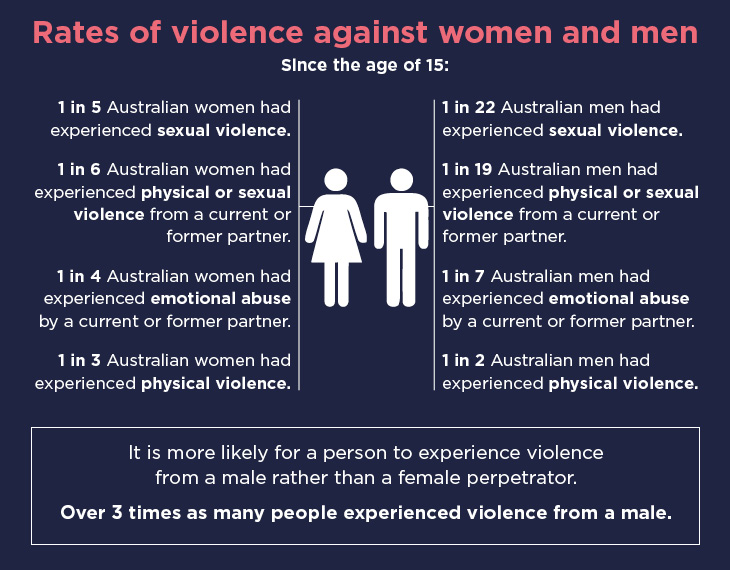Domestic violence is also commonly known as:
- Family violence
- Relationship violence
- Intimate partner violence
- Child abuse
Domestic violence is common in Australia.
It is a pattern of abusive behaviour through which a person seeks to control and dominate another person.
Domestic violence does not take the form of a single incident. It is ongoing behaviour that gradually undermines the victim’s confidence and ability to leave the violent person. The severity and frequency of violence often escalate over time.
This violence takes many forms, none of which is mutually exclusive. While physical violence may be the most visible form, others such as sexual, emotional, social, spiritual and economic abuse can be equally harmful.
Examples include:
- isolating a victim from family and friends
- controlling their access to money
- diminishing their self-esteem
- preventing them from practising their religious beliefs
- intimidating them, and
- threatening them.
Domestic violence is common in Australia. It is complex, and different from other forms of interpersonal violence.
WHERE DOES IT HAPPEN?
Domestic violence happens in all kinds of relationships, including:
- intimate: partners, lovers, husband and wife, ex-partners
- older people and their children (elder abuse)
- other family members, including step-parents
- parents and their teenage or adult children
- friends
- people with disabilities and their carers
When domestic violence occurs between adults in heterosexual relationships, research shows that men are most likely to be the perpetrators and women the victims.
When the violence occurs against children in families, research shows that parents and step-parents are most likely to be the perpetrators.
Children and young people also experience violence when they live with and/or witness violence between other family members.
This produces highly detrimental individual and social outcomes:
- Intimate partner violence contributes to more death, disability and illness in adult women than any other preventable risk factor.
- Approximately one in four women has experienced intimate partner violence compared to one in 13 men.
92 per cent of women physically assaulted by a man they know, most commonly a former intimate partner (42%). - On average, one woman per week is killed in Australia by a current or former male partner. [Australia’s National Research Organisation for Women’s Safety (2018); Australian Institute of Criminology (2017).]
- Family violence can occur in a range of relationships, including between current and former spouses or partners, parent/carer-child relationships, and relationships between siblings and other relatives, such as grandparents or extended family members. It also includes ‘family-like’ relationships such as paid or unpaid carers for people with disability, families of choice for LGBTIQ people, and cultural kinship networks in multicultural and Aboriginal communities.
Importantly, domestic violence is not solely a gendered problem but also an intersectional problem, driven by complex hierarchies of power, privilege and oppression with far-reaching impacts that reinforce structural disadvantage and marginalisation.
Research demonstrates that the populations most impacted by family violence are younger women, children, older people, people with disability, people from culturally and linguistically diverse backgrounds (including people with temporary residency status), LGBTIQ people, people in rural and remote communities, people with mental health issues and/or substance misuse problems, people from socio-economically disadvantaged areas and Aboriginal and Torres Strait Islander peoples. [Australian Institute of Health and Welfare (2019).]
Emerging evidence also shows that the rates of intimate partner violence within same-sex relationships are as high as the rates experienced by cisgender women in heterosexual relationships, and possibly higher for bisexual, transgender and gender diverse people.[Our Watch & GLHV@ARCSHS (2017)]

In Victoria, data on all family incidents attended by police are collated each year. The latest report for 2015–16 shows:
- 78,012 family incidents, an increase of 10% from the previous year
- of those affected, 74.8% were female and 24.8% male.4
The incidence of domestic violence is likely to be much higher than these figures indicate, as many incidents are never reported. This makes it even more important that our laws and punishments for these crimes are changed for the brave victims that speak up!
Enough is enough. The time for change is now!
Sources: https://www.dvrcv.org.au/about/what-domestic-violence and http://dvvic.org.au/understand/about-family-violence/
Quick Facts
• Across Australia, police are called out to a family violence incident on average once every two minutes
• Every three hours a woman is admitted to hospital as a result of domestic violence
• At least one woman a week is killed by a partner or former partner
• Intimate partner violence is:
‣ the leading contributor to preventable illness, disability and death for women aged 15 to 44
‣ the single largest driver of homelessness for women
‣ a common factor in child protection notifications
If you or someone you know is impacted by sexual assault, family or domestic violence, call 1800RESPECT on 1800 737 732 or visit www.1800RESPECT.org.au. In an emergency, call 000.
If you are worried about your behaviour, call Mensline on 1300 78 99 78 or visit mensline.org.au.


